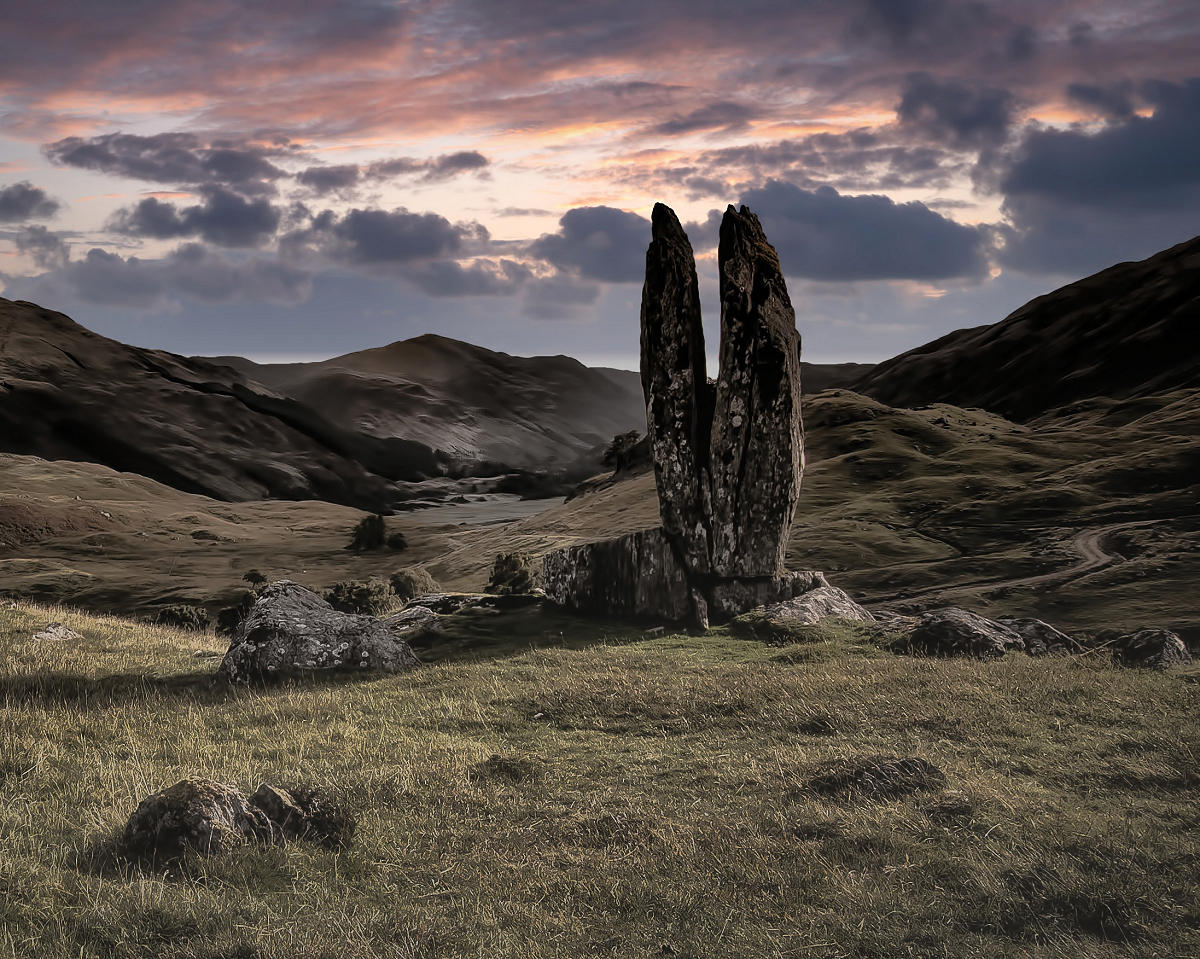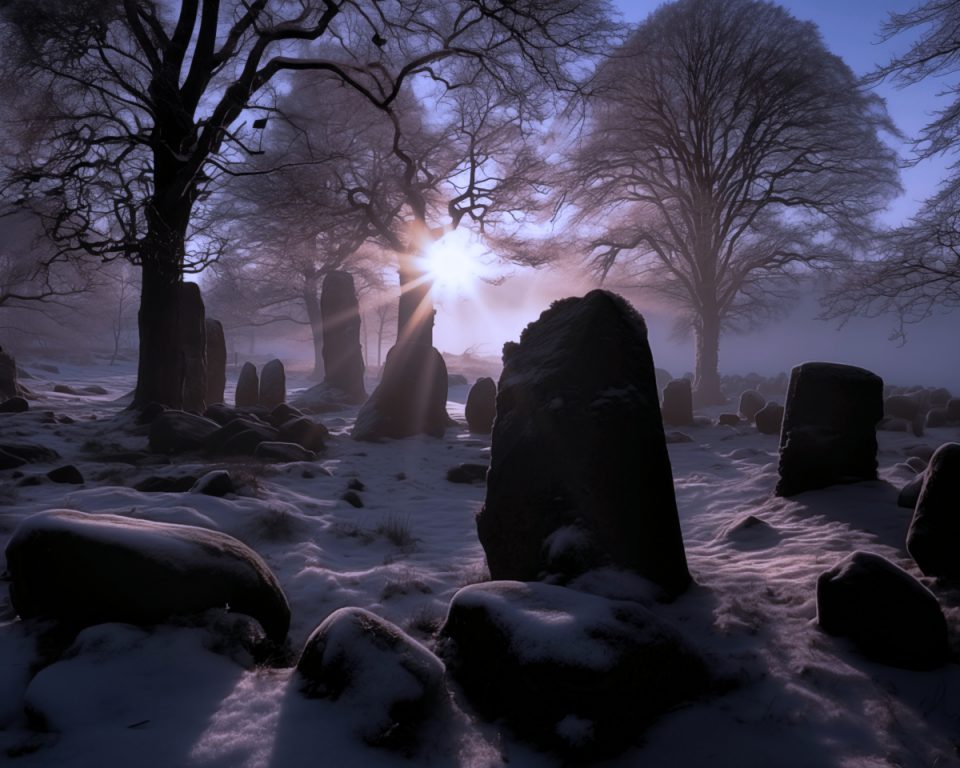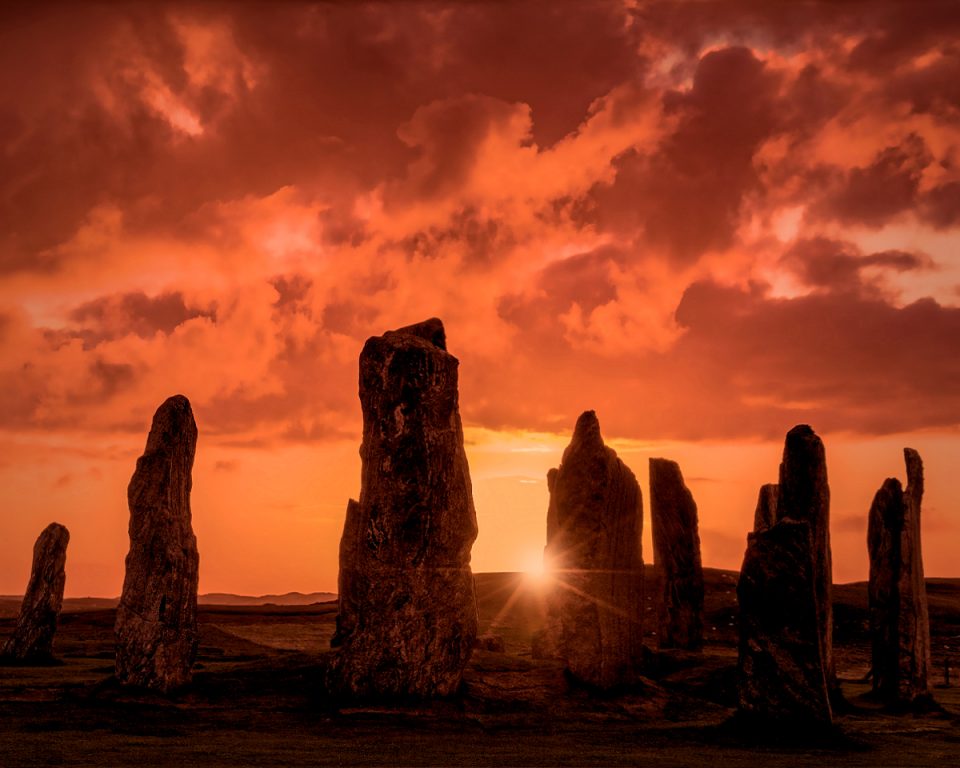Tigh nam Bodach is an ancient pagan shrine built to the Bodach and his wife, the Cailleach, in one of the remotest glens in Scotland’s heartland. Down through the centuries, it has been lovingly tended by the locals and kept largely hidden from the public eye. That is until a planned hydroelectric scheme threatened to destroy the tiny house. Fortunately, when the local historical society revealed the shrine’s existence, the scheme was shelved. But who or what is the Bodach? We hear of him in Scottish Folklore, a folk memory of a God from the mists of pre-history. Sometimes he is a ghost, that will come down the chimney and steal naughty children. Sometimes he is a benefactor, as the people from Glen Lyon will testify.
Glen Lyon
Glen Lyon in Perthshire is located on what was once the borderland of two ancient Scottish peoples: the enigmatic Picts and Gaels of Dal Riata. There is a feeling of something elemental and primaeval in this area. At the glen’s entrance is nestled the tiny village of Fortingall. Here, the parish church is home to the oldest yew tree in Scotland, an indicator that this was once the centre of an Iron Age pagan cult. The surrounding area has a high concentration of prehistoric sites including stone circles, a bronze age tumulus (burial mound), ring forts and cup and ring carved stones. Glen Lyon’s name is thought to be derived from the Celtic god Lugh.
The shrine, however, is located in another glen located deep within Glen Lyon. This is called Gleann Cailliche, named after the Cailleach, herself. It literally means the Glen of the Old Lady or the Glen of the ‘Veiled One’. Glen Cailliche has its own warmer micro-climate. Could this be the beneficence of the Bodach and the Cailleach?
Tigh Nam Bodach
The shrine literally means ‘The House of the Old Man’. It is not, however, a house in the common sense of the word. Rather it is a miniature stone bothy or sheiling with a turf roof. Nor is this the original structure. The stone walls need to be reconfigured every few years. What is it that compels the locals to take care of this place?
Perhaps it is the stones. During the summer months a stone family huddle outside their hut, looking eastward towards the shrouded summit of Meall Daill.
The Bodach and Cailleach Stones
There are seven stones altogether. The tallest of the stones, with a feminine torso and slender neck, is said to represent the Cailleach. In ancient times, the Cailleach was worshipped as the Goddess of Winter and Creator of humankind. Around her are ranged her spouse, the Bodach, the Nighean (their daughter) and another four stones said to represent other members of their family.
The stones are not man-made but have carved by the waters of the River Lyon giving them a beautifully raw and mystical appearance. No doubt this is what attracted the people who gathered the stones in the first place. None of the stones are more than one foot tall. Interestingly, the building materials for the hut are composed of quartz studded stone. Quartz was often used in ancient pagan ceremonies and burials such as at the Clava Cairns near Culloden Moor.
The Coming of Samhain
With the coming of Samhain, the ancient Gaelic festival we now celebrate as Halloween, the stone figures are returned into the shieling to spend the winter months undercover. They are brought outside again each year, with the coming of Beltane.
The Folk Tale behind Tigh nam Bodach
The unique ritual has deep roots in folklore. According to Doctor Anne Ross:
“The fragments … which have survived orally tell of an event which happened ‘many years ago’ when, in an unusually fierce snowstorm, an unnaturally large man and woman were seen coming down the mountain-side of the upper glen. They asked the people who were still settled there for hospitality and shelter. These were willingly given to them. This pleased the supernatural pair well and they took up residence in the glen when the inhabitants had built a thatched house large enough to accommodate them.”
“The woman was pregnant and in due course gave birth to a daughter. The weather was always favourable when they dwelt there. The stock flourished and the crops were always of the best. Then one day the time came when they must go. Before doing so, they promised that as long as they were remembered and their house kept in order, and everything done as they themselves had done it, they would bring it about that winters would be mild, the summers warm, and peace and prosperity would always be with the people who had been so generous to them.
In memory of this event of long ago a small shrine in the form of a house was constructed and every Bealtainn the three stones representing the three deities would be taken out of the house and placed facing down the glen. There they remained until the house was re-thatched and made warm and comfortable for the winter and they were returned to the miniature house on the eve of Samhuinn.”
Blessing and a Curse
Thus, the Cailleach and the Bodach provided a blessing through the year to that which people found most precious – their land, cattle, families and clan. However, there is also a Geas or Taboo attached to the stones. If anyone is to mishandle the stones or remove them from their house “very bad things” will befall them.
Links to the Nine Maidens
The first published reference to the site in a Perthshire history book from 1888, states :
“Shielings in the area were in use until after 1782 and the inhabitants regularly thatched it. Within there were twelve stones resembling human beings, perhaps associated with St Meuran and his eleven disciples” (Campbell 1888).
Some believe the writer avoided acknowledging their possible earlier origins for fear of upsetting the kirk. It seems that there were originally twelve stones. It has been suggested that along with the Cailleach, the Bodach and the Nighean, the other nine stones represent the Nine Maidens which also feature prominently in the folklore surrounding the Cailleach.
Other Local Traditions Relating to the Stone Figures
Local author and traditional storyteller Jess Smith has said:
“Water stones mould rather than break up or go jaggy, so they can take on the form of a human or an animal, and there is power in them.”
Smith spent much of her childhood on the road around Glen Lyon: “We heard about the drovers throwing meal and bread to the stones or their cattle would get sick. Places like this are very important. They live within the part of our psyche where we keep our respect for the ancients.”
Other Bodach Connections
Interestingly, there are other Bodach and Cailleach stones in other locations. On the Island of Gigha, the most southerly of the Hebridean Isles, stand another pair of stones similar in size and shape to the Glen Lyon stones. Similar legends are given to them. Surely this is no coincidence.
Throughout Scotland, landmarks are named after the Bodach. On the islands, there is Loch nam bodach ‘loch of the old man’ on Lewis, Carraig nam bodach ‘rock of the old man’ on Mull and Sloc nam bodach ‘hollow of the old man’ on the Isle of Colonsay. While on Arran there is Leanag nam Bodach ‘the little meadow of the old men’, Allt nam bodach ‘stream of the old man’ on the Isle of Islay and Buaile nam bodach ‘cattle-fold of the old man’ on the Isle of Barra.
Similarly, on the mainland there is Achadh nam bodach ‘field of the old men’ in Aberdeenshire, Cadh a’ bhodaich ‘the old man’s path’ near Nigg, Baile nam bodach ‘farm of the old men’ in Inverness-shire, and Drumore-na-bodach ‘big ridge of the old men’ in Kintyre.
Bodach and Cailleach Features Together
In the Cairngorms, the mountain Am Bodach is paired with the nearby A’Chailleach. Then there are two distinctive rocks off the coast of Cape Wrath which share these names. So widespread are their names that it seems that these were ancient deities venerated through the local landscape. Where the Cailleach’s name was used, the snow encircling the hill would be her petticoats and the long line of snow down her companion mountain would be the Bodach’s beard.
Once the Cailleach was the Mother Goddess of the early Scottish people, the creator of the land. She governed the winter months in tandem with another ancient deity, Brìde, the Goddess of Summer. The Bodach was the Cailleach’s husband. Interestingly, when the etymology of the word ‘Bodach’ is examined, ‘bod’ is Gaelic for penis. This is very fitting indeed for an ancient fertility God.
Changing Roles for the Bodach
When Christianity arrived, the early missionaries blended the ancient beliefs with the new religion. Brìde was beatified to become Saint Brigit. The Cailleach and the Bodach were vilified. The Cailleach became an old hag, jealous of the spring and the Bodach became a bogeyman who would snatch the unwary from the safety of home and hearth. In other cases, he became the Bodach Glas- the grey man, a portent of death.
A Reminder
For the early peoples of Scotland, the Bodach along with his wife were deities used to explain the lifegiving rhythms of nature and the passing of the seasons. Perhaps this is why the tiny hut, Tigh nam Bodach is so important. The rhythms of tending the stones are a reminder of our elemental connection with the earth and the turning of the seasons, without which none of us would survive.
Please feel free to share the spooky by using the links below or leave us a message in the comments box.




